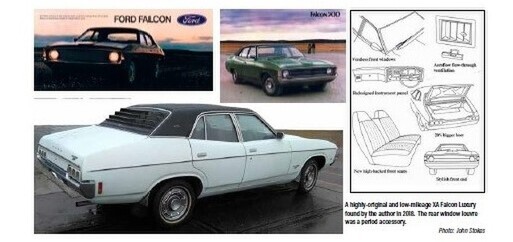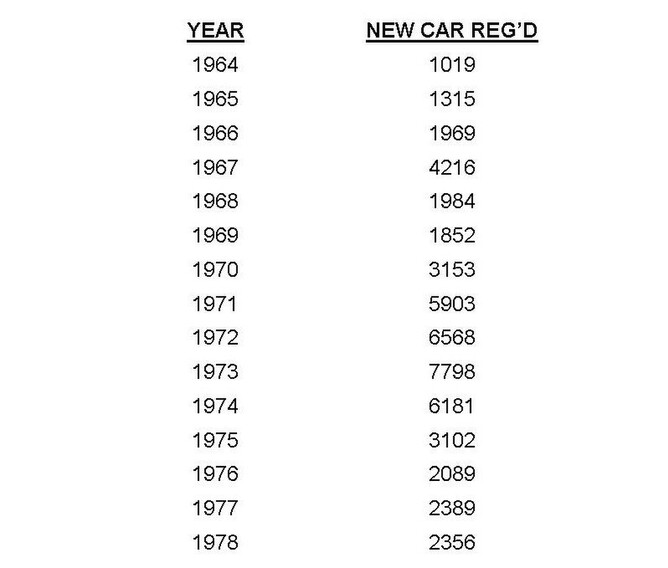I am often asked for production figures of vehicles Ford built here in New Zealand.
Sadly, I've never been able to get my hands on Ford-NZ production records. No-one seems to know what happened to them but I suspect either they were eaten by a very hungry mini-skip, or they were part of a large consignment of boxes that, just before I was on the scene, went off to The Discovery Centre, Ford-Australia (Geelong) and which is now closed.
But there is one Ford model for which we can get a pretty good idea of production numbers. That is, Falcon, for the period 1964 to 1978.
Ford of Australia commenced Falcon production in 1960. The first of the Falcons to arrive in New Zealand, being the XK and the XL, were mostly a few private imports. It was not until 1964 that the Ford Motor Company of New Zealand began to import the Falcon in serious numbers. With that, very helpfully the Motor Trade Association (MTA) added the Falcon to their annual New Car Registration statistics, and these were not lumped in with the other Fords - the Falcon was separated out and shown by name! This deviation was unique to Falcon, and it would continue to and including the figures for 1978. All others were shown by cc rating. So, a 1600cc car might be an Escort, Capri or Cortina.
Perhaps Falcon was isolated in the MTA registration stats so that the MTA could track how the Falcon was performing, possibly against the Ford Zephyr but more likely against the Falcon’s trans-Tasman competitors, General Motors Holden and Chrysler Valiant, which were shown in the stats.
The first of the Falcons Ford - NZ imported, being the XM and XP, were station wagons. Station wagons, or estates, were a relatively new design and GM-H had taken full advantage of the demand here in New Zealand. Think about the number of Holden Special station wagons that were around back then? But Ford of Britain wasn't making estates in Zephyr form, other than to send Zephyr sedans off to a coachbuilder to have them converted into estates, and at quite a price. So Ford of Australia building them was a god-send, and Ford New Zealand could fill that hole in the market. Some sedans were brought in, but probably only to order. The reason for this is simple – at the time the Zephyr 6 was selling at £1,228 and the Falcon sedan was cheaper, at £1,198. (Ford could not adjust the pricing to suit – pricing was controlled by the government!)
It was not until late-1966 that Falcon assembly commenced in New Zealand, with the all new “Mustang-bred” XR Falcon. A locally-assembled XR Falcon was now priced at £1,175. Because of Britain’s new relationship with the European Economic Community (EEC) prices of British-made products had become significantly more expensive – and this was reflected in the just-released and all-new Mk IV Zephyr, in the showrooms at £1,434. The price difference from a Falcon was enormous, so little wonder New Zealand buyers began to favour the big Australian car over it's British equivalent. Indeed, because Mother England had seemingly abandoned us now, New Zealand began to look elsewhere as an alternative source of new cars. In particular, we looked to Japan.
In July, 1967 New Zealand changed to decimal currency. The pound was gone – we now had dollars. And for each pound that we exchanged at the bank we got two of the new dollars. We suddenly felt wealthy! But prices had “doubled” too – now the XR Falcon was priced at $2,478 and the Mk IV Zephyr became $3,022.
There were many influences that affected new car sales during that period and the market was still tightly controlled. Joe Average, if he was able to convince a new car salesman to please allow him buy one of his new cars, would be happy with just about anything that had four wheels. So, knowing that anything would sell regardless the various assemblers, including Ford, just stuck to ordinary, everyday models. This explains why Falcon Hardtops, for instance, were not assembled here, and nor were any Falcon GT models. Even the later Fairlanes were imported built-up, despite the fact that they were built on the same platform as the longer Falcon station wagons that we were assembling.
So, the MTA figures on the table below are NOT production statistics. They ARE first-time registrations of new cars. The great majority of those newly registered cars will have been locally-assembled. A few – maybe 5 percent – will have been new cars that arrived CBU (completely built-up, or assembled overseas).
(Also, the figures DO NOT include used cars from overseas.)
When trying to interpret these figures we also need to ask ourselves, what is a Falcon? In other words, do these figures include Fairmont and the other Falcon variations all the way to LTD, for instance? The short answer is, we don't know.
However in 1972, in addition to the 6,568 Falcons shown on the table, there were another 1,347 Fords that you can't see that were also newly registered which were over 2700cc (the MTA parameters). These will be 3-litre Zephyrs and Zodiacs and Capris. But would there be, say Fairmonts amongst that 1,347 figure? I think most probably not because, looking at the same thing for 1975, there were just 27 Fords over 2700cc newly registered. This will be the last of the V6 Capris. Then, as if to prove that theory, for 1976 there were 2,089 Falcons newly registered, and no Fords over 2700cc. This is true also of 1977 and 1978!
So, whilst we don't have the actual Ford New Zealand production figures for Falcon, these New Car Registration stats give us a pretty good idea!
It is such a pity that we are unable to analyse other models in Ford's New Zealand product range in this way. But without further ado, here is the NEW CAR REGISTRATION TABLE, for FORD FALCON 1964 to 1978:







